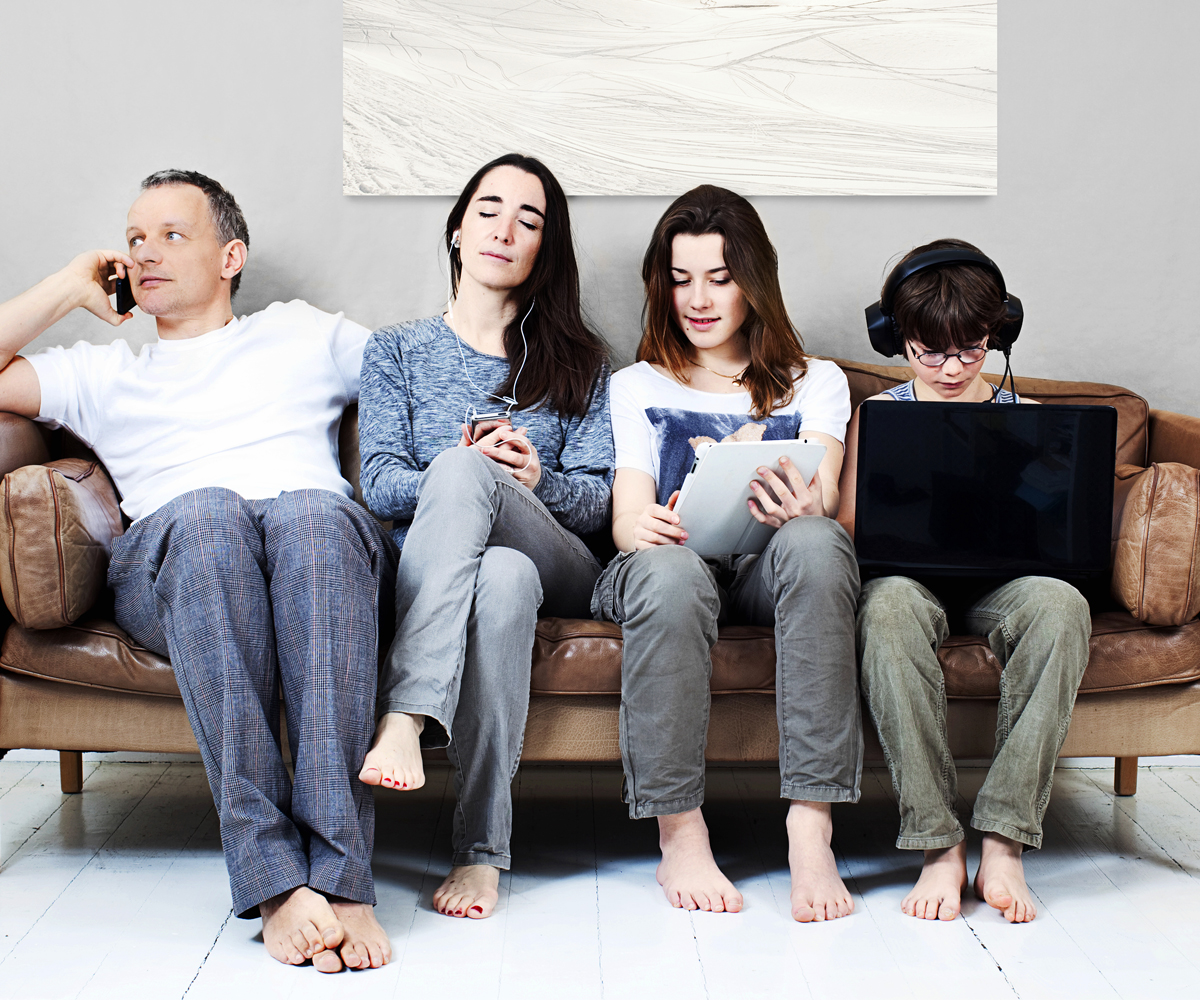Hand-held electronic devices like smart-phones, tablets and eBook readers, as well as laptops, have revolutionised our lives.
They can make tasks so much easier (isn’t it great being able to pay bills without getting off the sofa?), help us stay in touch with others, and inform and entertain us for hours.
But there are downsides to devices. They can sometimes be bad for our health if we’re not careful and digital technology can have a huge impact on family dynamics if we spend too much time engrossed in what’s happening on our screens.
Here are a few points to bear in mind when it comes to how you and your family use devices.
Health hazards
Bad posture and neck, back and shoulder pain
Hunching over laptops and devices, and constantly looking down at them can lead to a host of problems, including sore shoulders, neck and back.
To counter this, raise the screen to eye level so you are not bending forward and prop it up against a surface
so your arms don’t get sore holding it up.
Take frequent breaks (muscles can seize up if you stay in one position without moving), and stretch your arms, neck and back.
Limit how much time you spend looking at the screen too – use the alarm on your device to help monitor this.
Sore arms and wrists
Overuse injuries such as carpal tunnel syndrome can result from too much time on devices and laptops, especially if you are doing repetitive movements such as using a mouse.
You can also end up with pain in your elbows if you sit for long periods with your arms bent holding a device.
Texting or doing the motions used to play games can injure nerves and tendons too so, again, limit your time, don’t stay in one position for too long and frequently stretch your arms.

Eye strain
Excessive screen time has been linked to vision issues such as eye strain, dry eye and problems focusing.
The bright lights emitted by screens can lead to you squinting, which strains the eyes. And if you find yourself so enraptured by what you’re looking at that you don’t blink often, this can evaporate tears and contribute to dry eye.
Magnify the text so you aren’t straining and have mini-breaks to rest your eyes.
Headaches
The combination of eye strain and tension in the muscles at the base of the neck can bring on a headache. And if you get so caught up in what you’re doing on your device that you forget to drink, this can lead to dehydration, which makes headaches worse.
Stress
Devices can bring us a lot of joy – funny cat memes, clips of surprise family reunions, photos of loved ones who live a long way away – but they can also be the source of stress.
Some social media and online chat forums can leave you feeling inadequate, anxious, angry and depressed, while frequently reading bad news can also take a toll. The feeling of powerless to put down your device when you know you should be doing other things can also cause enormous stress.
Once more, limiting the amount of time you spend on it is crucial, as is filtering what you look at.
Obesity
Hours spent on a device often mean a lack of physical activity, which can contribute to weight gain and difficulty shedding excess kilos.
Make sure you balance screen time with being active.
Poor sleep
The light emitted by screens can wreak havoc with our circadian rhythms, fooling our bodies into thinking it’s daytime and making it difficult to fall asleep.
Try not to look at screens for at least an hour before you head off to bed.
Addiction
It is possible to become addicted – not so much to your device itself, but to some of the things you can do on it, such as playing games, trawling through social media sites or becoming hooked on the content offered by certain websites.

Having screen time rules that apply to the whole family – and sticking to them – is important. Image:Getty Images
Devices and family dynamics
Jenny Hale finds herself dealing with the issue of families grappling with the impact of digital technology more and more these days.
A senior family coach at Parenting Place, an organisation that supports parents, she says devices and their use can have a huge effect on family dynamics and relationships, and it is crucial for parents to set boundaries about what’s acceptable and what isn’t.
Here are some of her guidelines to navigating what can be a minefield:
Do your kids really need a device?
The introduction of Bring Your Own Device (BYOD) policies at schools has opened the flood-gates for personal usage.
Many families have had to invest in tablets or laptops for their children to do their schoolwork and as a result, a lot of kids are likely using them for other online activities as well. Jenny says if your child doesn’t have to have a device for school, it’s worth not getting one for as long as possible.
“Try to hold out for as long as you can. We shouldn’t buy into the fact that children must have these things.”

Used appropriately, smartphones and tablets are great for educational purposes Image: Getty Images
Set rules about devices as soon as possible
Providing clear rules from the moment your children start using devices and going online helps to establish good habits.
If they know they can only be on their device for an hour after school to do homework, they will cope better than if you suddenly introduce restrictions after previously having unlimited time on their devices.
But even if you haven’t been good at setting rules, it’s better late than never when it comes to overseeing their online time.
Don’t be afraid to “re-set”
If you think the use of devices in your household is out of control, do a “digital re-set”. Revise the rules or become tougher if need be.
Explain that the new guidelines are not meant as a punishment, just a way to take control over how much technology is used.
You may have to update the rules several times to get things back on an even keel, but it’s better to do that than let things spiral out of control, says Jenny.
Set a good example
Parents assume their children must be spending more time on devices than they are, but that’s not always the case.
“We can spend more time looking at our phones than we realise and kids do notice. So when we then put restrictions on our children, we are being hypocritical. We’re not walking the talk.”
Having screen time rules that apply to the whole family – and sticking to them – is important. For example, if you decide devices can’t be used at the table or must be turned off and put away at 9pm, everyone needs to adhere to that.

Too much screen time can have a detrimental effect on your body, your ability to sleep and your relationships. Image:Getty Images
Check their screen time
Many devices – particularly those released in the last few years – have a setting that shows you how much screen time is being used.
Make a habit of checking this usage with your children as it can provide a great opportunity to start a discussion on the appropriate use of online time.
Don’t demonise devices
Smartphones and tablets are not evil – they can just cause major issues if not used appropriately. Remember they can be great for educational purposes and for keeping in touch with others, and see that they are used accordingly.
Be interested in what they’re doing online
Just as we might sit and chat with our kids about TV shows we’ve been watching, initiate conversations about what they are doing online. This helps to build vital connections.
“Spending a lot of time on a device can create isolation from the rest of the family, which is concerning,” Jenny says.
“Children need regular connections with the people who are important to them and they’re not getting that if they are always immersed in what’s happening on screen.”
The Parenting Place website features a contract a family can print off and sign regarding technology usage. It has a section for each member to sign, in which they agree to terms such as:
• Not giving out a credit card number to anyone online
• Not installing any downloaded programmes without permission
• No livestreaming in a private place
There’s also a part outlining family policies towards technology, including:
• Not using devices during mealtimes
• Looking at the person speaking to you and not at the device you are holding
• Having times when nobody is allowed to use their device
• Believing online connection can never replace real-life connections



.jpg)
